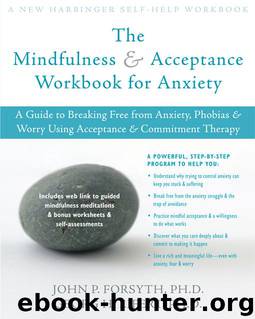The Mindfulness and Acceptance Workbook for Anxiety: A Guide to Breaking Free from Anxiety, Phobias, and Worry Using Acceptance and Commitment Therapy by Eifert Georg H. & Forsyth John P

Author:Eifert, Georg H. & Forsyth, John P. [Eifert, Georg H.]
Language: eng
Format: epub
ISBN: 9781608821440
Publisher: New Harbinger Publications
Published: 2008-01-02T00:00:00+00:00
Willingness Makes Growth Possible
You may think it would be much easier to be willing if you didn’t have the pain you feel, if you weren’t experiencing all those intense feelings and thoughts. Yet it is not the absence of trauma, pain, and intense, unpleasant feelings and thoughts that keeps people healthy.
Studies in many countries have found that the difference between health and suffering is whether people are willing to experience the totality of their psychological and emotional world and still do what matters most to them. Ultimately, willingness is about finding a way to live a meaningful and productive life with your pain. When you are willing to live such a life and take the totality of personal pains and joys along for the ride, you’re on your way out of suffering.
We aren’t saying this is easy. And yet this type of pain—having anxiety and doing what matters—is like a growing pain. Remember the story about the emperor moth in chapter 5. Being cut off from the experience of pain and struggle wasn’t helpful to the moth. It never learned to fly.
At times, your old knee-jerk reaction of struggling with WAFs will occur so fast that it’ll take a moment to recognize that you’re caught up in the tug-of-war again. When that happens, notice what’s going on and then let go of the rope. You’ve just been sucker punched into struggling. Give yourself three seconds to recover. Pull yourself up and then exert your response-ability for what you do next. It’s just a passing phase before you can take off and fly.
Always remember that you can make a different choice by adopting the stance of willingness—by opening up and softening to the experience of anxiety. You can live a vital and meaningful life if you’re willing to have and experience anxiety.
Exercise: The Willingness Switch
Imagine you had two switches in front of you. They look like light switches and both have an on/off setting. One switch is called “anxiety” and the other is called “willingness.” It seems like both switches can be turned on or off. When you started reading this book, you were probably hoping to find a way to turn the anxiety switch off. Based on your experience, this turned out to be a false hope. The on/off toggle of the anxiety switch isn’t working. This may even make you feel like you’re a victim of anxiety, that you’re helpless. And your mind says, “That sucks.” You’re disappointed over and over again.
So we’d like to share a secret with you. The willingness switch is really the more important of the two because it’s the one that will make a difference in your life. Unlike the anxiety switch, you do control the willingness switch. When it comes to willingness, you’re not a helpless victim because that switch is controlled by your actions. Remember, this is the place where youareresponse-able. It’s your choice to flip the willingness switch on or off.
We’re not sure what would happen with your anxiety if you switched the willingness on.
Download
This site does not store any files on its server. We only index and link to content provided by other sites. Please contact the content providers to delete copyright contents if any and email us, we'll remove relevant links or contents immediately.
Rewire Your Anxious Brain by Catherine M. Pittman(18552)
Talking to Strangers by Malcolm Gladwell(13222)
The Art of Thinking Clearly by Rolf Dobelli(10220)
Mindhunter: Inside the FBI's Elite Serial Crime Unit by John E. Douglas & Mark Olshaker(9200)
Becoming Supernatural by Dr. Joe Dispenza(8119)
Change Your Questions, Change Your Life by Marilee Adams(7635)
Nudge - Improving Decisions about Health, Wealth, and Happiness by Thaler Sunstein(7615)
The Road Less Traveled by M. Scott Peck(7522)
The Lost Art of Listening by Michael P. Nichols(7406)
Enlightenment Now: The Case for Reason, Science, Humanism, and Progress by Steven Pinker(7228)
Mastermind: How to Think Like Sherlock Holmes by Maria Konnikova(7227)
Win Bigly by Scott Adams(7094)
The Way of Zen by Alan W. Watts(6505)
Daring Greatly by Brene Brown(6444)
Big Magic: Creative Living Beyond Fear by Elizabeth Gilbert(5610)
Grit by Angela Duckworth(5523)
Ego Is the Enemy by Ryan Holiday(5294)
Men In Love by Nancy Friday(5155)
Altered Sensations by David Pantalony(5045)
